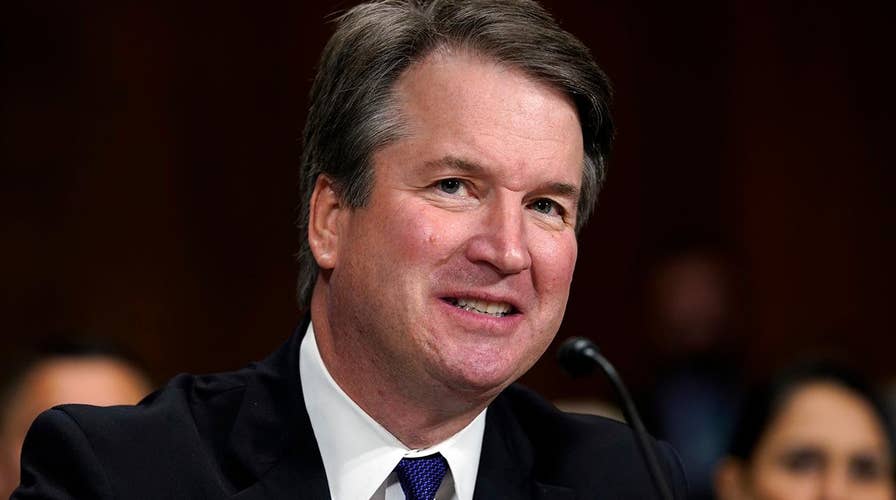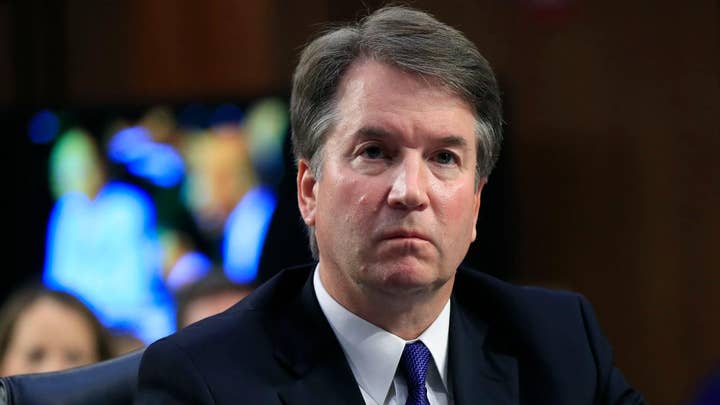Breaking down the scope of the FBI's Kavanaugh investigation
President Trump calls for a 'comprehensive' FBI investigation of sexual misconduct claims against Supreme Court nominee Judge Brett Kavanaugh; insight from Berit Berger, former assistant U.S. attorney for the Southern District of New York.
All eyes are on the FBI and when its agents may complete their probe of the allegations leveled against Brett Kavanaugh by Christine Blasey Ford. The original plan was for Senate Majority Leader Mitch McConnell, R-Ky., to launch a parliamentary sequence over the weekend which likely would have resulted in a confirmation vote by Tuesday or Wednesday. But that’s been pushed back.
What happens if the FBI finds something new? What if the inquiry poses other questions? Democrats must be careful to not overplay their hand on this or the public could view their gambit as a clear ploy to delay.
Here's where we stand:
The Senate is technically on the Kavanaugh nomination as we speak, although there’s been no formal floor debate yet. That said, McConnell has queued up a long-term re-authorization of the Federal Aviation Administration (FAA) first. So, the FAA legislation will likely consume must Senate traffic until Wednesday.
The thing to watch for in the Senate is when McConnell “files cloture” or moves to end debate on the Kavanaugh nomination. Once McConnell makes this move, the Senate starts a four or five-day calendar to complete the nomination.
We don’t believe McConnell will move to end debate until Wednesday at the earliest. But could McConnell do so even though the FBI probe isn’t complete? That’s a risk for McConnell. Such a maneuver could be viewed as jumping the gun and violating the accord he reached with Sens. Jeff Flake, R-Ariz., Susan Collins, R-Maine, and Lisa Murkowski, R-Alaska. McConnell must be very careful not to pull the trigger too early. He needs to satisfy the triumvirate of Collins, Murkowski and Flake.
Some conservatives heaped lots of criticism on Flake over the weekend for delaying the confirmation of Kavanaugh. But truth be told, Flake may very well have salvaged Kavanaugh’s embattled nomination.
It's about the math.
Right now, Kavanaugh has 48 hard yea votes. Sen. Mike Enzi, R-Wyo., is unannounced but is not believed to be a problem. So let’s put Kavanaugh at 49 yeas. Close, but not quite there. Had Flake not intervened, Kavanaugh likely would have no change of securing the votes of Collins, Murkowski and potentially Sens. Heidi Heitkamp, D-N.D., and Joe Manchin, D-W.Va. Justice Clarence Thomas marshaled only 52 yeas when the Senate confirmed him in 1991. The delay opens the door for Kavanaugh potentially to score as many as 53 yeas.
But they’re not there yet.
Kavanaugh’s self-professed love of beer has now emerged as a tipping point for the nomination.
“I was surprised at how vocal he was about the fact that he liked beer,” said President Trump about his nominee this morning in the Rose Garden.
In 1989, President George H.W. Bush nominated former Sen. John Tower, R-Texas, to be defense secretary. But, Tower’s nomination drew a panoply of criticisms from the Senate, the very club in which he served for decades. Senators claimed he was a womanizer and not conservative enough. Then, came allegations of alcohol abuse.
The questions about Tower’s drinking seemed to push things over the line for him.
In a rare rebuke to one of their own, the Senate rejected Tower’s nomination 53-47. President Bush then tapped then House Minority Whip Dick Cheney, R-Wyo., to serve as secretary of defense.
So, the Senate now sits in a stasis on Kavanaugh through at least Wednesday, as everyone waits to see when McConnell may file cloture and attempt to bring debate on the Kavanaugh nomination to a close. Again, we expect no parliamentary maneuvers by McConnell until at least Wednesday, if not Thursday or later.
Here’s a prospective timetable:
DAY ONE: McConnell files cloture to end debate on the nomination. This step is necessary to break a filibuster.
DAY TWO: By rule, a “cloture petition,” the parliamentary mechanism to end debate in the Senate, must lay over untouched for an entire day before it “ripens” and is ready for a procedural vote. Day Two serves as the layover day.
DAY THREE: By rule, the cloture petition to halt debate “ripens” one hour after the Senate meets. If the Senate is really trying to maximize its time, it could start the Senate day at 12:01 a.m. ET on Day Three. Thus, the cloture petition to draw debate to a close would “ripen” at 1:01 a.m. ET, and be available for a procedural vote. This requires 51 votes. If the Senate votes to “invoke cloture” or limit debate, opponents of the nomination then get 30 hours to run out the string. But only 30 hours.
- Under “Nuclear Option II,” McConnell established a new “precedent” in the Senate to end filibusters on Supreme Court nominees last year. It used to take 60 votes to end debate on a Supreme Court nominee. But, McConnell lacked the votes to clear the filibuster Democrats lodged against Supreme Court Justice Neil Gorsuch. So McConnell instituted a new precedent, lowering the bar to break a filibuster on a Supreme court nominee from 60 to 51.
DAY FOUR: The 30 hours of “post-cloture” time expires on the nomination. Opponents can no longer pull rabbits out of hats. The Senate takes a confirmation vote on the nominee. Confirmation requires a simple majority.



























